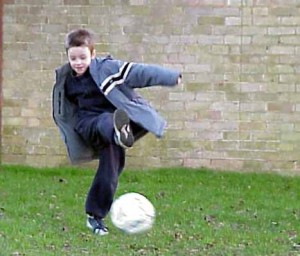Home advantage and the resulting roar of the crowd have less influence on today’s referees, according to new research at the University of Wolverhampton.
 The radical transformation of training for officials since World War 2 was identified by experts as the main reason behind the change.
The radical transformation of training for officials since World War 2 was identified by experts as the main reason behind the change.
The biggest decline in home advantage was observed in the lower divisions, which have smaller crowds, suggesting that large football crowds do still have some impact on referees.
Experts devised a mathematical formula to analyse results for teams in the professional English Leagues and Scottish Premier Leagues since World War 2. Factors such home team advantage and a team’s ability were taken into account.
Professor Alan Nevill, from the School of Sport, Performing Arts and Leisure, led the study, which has been published in the journal Psychology of Sport and Exercise.
He said: “Crowds are known to influence referees’ decisions to favour the home side. However, we argue that improved training of referees since WW2 has contributed to an improved ability to make objective decisions and a greater resilience to crowd influence. This explains the decline in home advantage but also accounts for the steeper decline observed with smaller crowds.
“There have been dramatic developments in the way referees are trained to cope with the pressures associated with the ever-increasing demands of the game. At the same time, professional sport has developed into a business with enormous financial rewards and there is immense pressure on football’s governing bodies to ensure justice is seen to be done.
“Consequently, the training of referees has undergone a complete transformation from being an amateur hobby immediately post-WW2 when referees received little or no training, to one of the best prepared and monitored referee groups in the world.”
Other possible reasons for the decline in home advantage include improved travelling conditions, less familiarity with the playing surroundings (even at home) and TV coverage. But the researchers believe the improved training of referees is the most likely explanation.
Professor Nevill adds: “The systematic training of referees seems the most plausible explanation, especially given the steepest decline in home advantage occurred in the lowest division of the Football League with the smallest crowds. Whilst the impact of improved training and use of coping strategies can account for the systematic decline in home advantage, its continued existence, and less steep decline in the Premier League, suggests that referees’ objective capabilities are still not immune to the unconscious influence of the crowd. It could be that referees seek to appease the crowd and it is possible that the larger the crowd, the more likely this is to occur.
“Immediately after WW2, referees were ill-prepared to cope with the psychological pressures that large and vociferous crowds could inflict upon them and their decision-making processes. This lack of awareness and limited training has been totally transformed.”
The research, titled Improved training of football referees and the decline in home advantage post WWII, was carried out by Professor Nevill with Adam Watts from the University of Wolverhampton and Tom Webb from the University of Portsmouth; Psychology of Sport and Exercise Volume 14, Issue 2, March 2013, Pages 220–227, published by Elsevier.
[otw_is sidebar=otw-sidebar-1]


